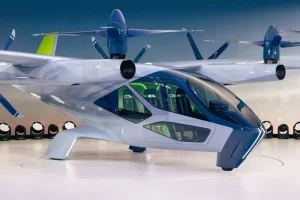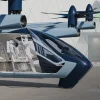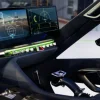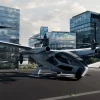- Directory
- Electrified Aircraft
- All-Electric Aircraft
- All Electric eVTOL
- Supernal S-A2
Supernal S-A2
Hot
2508 1 3 1
Operational Information
Overview:
The Supernal S-A2 is a cutting-edge electric vertical take-off and landing (eVTOL) aircraft developed by Supernal, a subsidiary of Hyundai Motor Group, as part of their Advanced Air Mobility (AAM) initiative.
Aircraft type:
Aircraft Model
S-A2
Manufacturer
Supernal
Country
SOUTH KOREA
Crew
- Piloted
Propulsion
- Electric Multicopter
Enter service date.
2028
Cost
NA
Website
http://www.supernal.aero
Performance and Capacity
Propellers:
- 8 tilting rotors
Motors
- Brushless DC electric motor (BLDC)
Power source:
- Battery
Passenger Capacity
4
Range
40 Miles
Maximum Range
NA
Cruise speed
120 MPH
Maximum Speed
NA
Cruise altitude
1,500 ft
Maximum Altitude
NA
Noise at hover
< 65 dBA
Noise at cruise
< 45 dBA
Time to recharge
NA
Maximum Takeoff Weight
NA
Aircraft Design and Dimensions
Height
NA
Width
NA
Cabin lenght
NA
Cabin height
NA
Cabin width
NA
Supernal S-A2 eVTOL:
The Supernal S-A2 is a pioneering eVTOL (electric vertical take-off and landing) aircraft designed by Supernal, a Hyundai affiliate. It is intended to seamlessly integrate into future urban environments and transform urban air mobility. As part of Hyundai's vision for future transportation solutions, the S-A2 is expected to be a cornerstone in establishing a new ecosystem of urban air transportation, emphasizing Hyundai's commitment to innovation and intelligent mobility.
Development
Launched under Hyundai's broader mobility solutions, the Supernal S-A2's development signifies a significant technological leap. Its development harnesses Hyundai's vast resources, expertise in automotive manufacturing, and cutting-edge aerospace technology. This strategic fusion aims to meet rigorous safety standards and navigate the complex regulatory landscape, mainly focusing on integration within urban infrastructures—a critical step towards certification and operational viability.
Performance and Capabilities
Designed to accommodate up to five passengers, the S-A2 promises a range of up to 100 kilometers and a top speed of 300 km/h. Its electric propulsion system not only allows for rapid recharging but also offers the benefits of reduced noise and emissions compared to traditional rotorcraft. The aircraft features distributed propulsion, enhancing safety through redundancy and improving aerodynamic efficiency, which is crucial for operation in dense urban settings.
Market Competition
The S-A2 competes with major players like Joby Aviation, which focuses on longer-range capabilities, and Archer Aviation, which has secured strategic partnerships for market entry. Volocopter and Lilium also present competition with their distinctive designs and targeted market segments. However, Supernal's S-A2 benefits significantly from Hyundai's industrial might, providing an edge in scalability and potential cost efficiency. Additionally, its focus on autonomous flight technology could further distinguish it in a market geared toward pilotless solutions.
Competitors
- Joby Aviation
- Aircraft Features: Joby's eVTOL design emphasizes a higher range (up to 240 km) and faster speed, catering to slightly longer urban and suburban routes.
- Advantage: The Joby aircraft is one of the few to have achieved FAA Part 135 Air Carrier certification, advancing its operational readiness.
- Archer Aviation
- Aircraft Features: Archer's "Maker" eVTOL focuses on urban air mobility and is designed for a range of approximately 100 km, similar to the S-A2.
- Advantage: Archer has significant investments and partnerships with United Airlines, which could facilitate quicker commercial deployment.
- Volocopter
- Aircraft Features: Volocopter focuses on intra-city travel with a slower speed and shorter range, emphasizing accessibility and ease of operation.
- Advantage: It has conducted numerous public test flights and demonstrations, building public trust and regulatory rapport.
- Lilium
- Aircraft Features: Lilium's jet features a unique ducted fan design, providing a balance of speed and range with vertical and horizontal flight capabilities.
- Advantage: Lilium targets regional air mobility, slightly different from the strictly urban focus of most eVTOLs.
Development Progress and Future Outlook
Supernal is in the advanced stages of development with the S-A2, conducting extensive testing to ensure the aircraft meets all operational and safety benchmarks. The company is proactively collaborating with urban planners and regulatory bodies, setting the stage for smooth integration into global urban transport networks by the projected commercial launch in 2028. Looking forward, Supernal plans to expand the aircraft's applications to encompass passenger transport, emergency services, and cargo delivery, aiming to exploit the eVTOL platform's versatility fully.
Conclusion
The Supernal S-A2 represents a transformative advance in urban air mobility, potentially reshaping how cities function and residents commute. By leveraging Hyundai's automotive expertise and smart mobility vision, the S-A2 stands out as a holistic solution designed to meet the future demands of urban transportation, making it a significant player in the evolution of global mobility strategies.
For a more detailed exploration of the Supernal S-A2, visit the official [Supernal website](https://www.supernal.aero/aircraft/).



